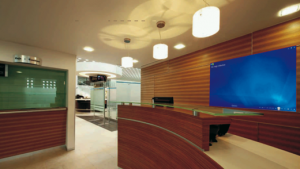 Track2Realty: Net office uptake in the first three quarters (Jan – Sept) of 2014 has seen a significant rise of 36% as compared to same time last year. Total net absorption of office space has been recorded at approximately 24 million square feet (msf) between January – September in 2014 as against the 17.7 msf in same time in 2013, says Cushman & Wakefield in a report.
Track2Realty: Net office uptake in the first three quarters (Jan – Sept) of 2014 has seen a significant rise of 36% as compared to same time last year. Total net absorption of office space has been recorded at approximately 24 million square feet (msf) between January – September in 2014 as against the 17.7 msf in same time in 2013, says Cushman & Wakefield in a report.
NET ABOSRPTION (JAN – SEPT 2014)
| City | Jan – Sept 2014 | Jan – Sept 2013 | YTD |
| Ahmedabad | 1,139,100 | 356,590 | 219% |
| Bengaluru | 6,191,154 | 3,225,806 | 92% |
| Chennai | 2,018,149 | 1,391,511 | 45% |
| Hyderabad | 3,873,673 | 2,100,179 | 84% |
| Kolkata | 625,576 | 773,882 | -19% |
| Mumbai | 3,620,975 | 3,572,493 | 1% |
| NCR | 4,548,030 | 3,351,656 | 36% |
| Pune | 2,216,532 | 2,988,444 | -26% |
| TOTAL | 24,233,189 | 17,760,561 | 36% |
During YTD 2014, Ahmedabad, Bengaluru and Hyderabad witnessed the highest increase in net absorption; Ahmedabad recorded the highest over two – fold increase in net absorption in 2014, albeit on a smaller base. Bangalore witnessed an increase of 92% in net absorption during YTD 2014 over the same period in 2013 and was noted at 6.2 msf.
Hyderabad saw an increase of 84%, recording a net absorption of 3.8 msf. and continued to outperform Mumbai essentially due to the substantial increase in pre-committed absorption during this period.
On the other hand cities namely Pune and Kolkata office market saw a decline of 26% and 19% y – o – y in total net absorption respectively.
The top performing cities were Bengaluru (6.2 msf) and Delhi-NCR (4.5 msf) and constituted approximately 45% of the total net absorption in YTD 2014. YTD Net absorption in Bengaluru has already exceeded the annual net absorption of 2013 which was recorded at 4.7 msf owing to strong demand from IT-ITeS companies. The leasing activity in NCR was also dominated by IT-ITEs companies with absorption in Q3 contributing more than 50% to its performance.
In the same time, supply across the top 8 cities recorded at 24.8 msf marginally increased by 4% as against YTD 2013. Overall vacancy levels too declined to 18.4% at the end of Q3 2014.
Sanjay Dutt, Executive Managing Director, South Asia, Cushman & Wakefield said, “The office markets have seen a positive trend as the economic growth improved from all-time lows and business confidence strengthened. Companies have started to expand their operations and new leases and expansion now constitute 75% of the leasing activity in the country with relocations and consolidations witnessing a decline over last year. We will continue to see this positive momentum in the next 2-3 years with net absorption likely to outstrip new supply from the year 2016.”
City Overviews
Ahmedabad
Total supply for the first three quarters of 2014 was recorded at 1.7 msf, a substantial increase of 74% compared to same period last year as a number of developments that were deferred in the previous year became operational. Net absorption in the first three quarters of 2014 was noted at 1.1 msf which is more than double the same period last year.
This is owing to new leases and pre-commitments measuring 400,000 sf that were taken up during the said period. Net absorption (in the first three quarters) was concentrated in Gandhinagar (36%), Prahladnagar (35%) and S.G. Highway (26%). Transaction activity in 2014 was primarily driven by the IT-ITeS (49%), BFSI (28%) and manufacturing (13%) sectors.
Although the average transaction size remained similar to last year same period at 12,000-15,000 sf, the increase in number of deals in the IT-ITeS and manufacturing sector led to the increase in net absorption. Other sectors that added to the increase are media and pharmaceuticals. With high levels of supply, vacancy levels increased by 4.6 percentage points to 18.5% at the end of the third quarter. Given the high vacancy levels rentals in most submarkets have largely remained stable over the last year.
Bengaluru
During the first quarter of 2014, 5.5 msf of office space became operational in Bengaluru, all of which belonged to Grade A category and was 19% more than the same period in 2013. 67% of the supply was infused in peripheral submarket, followed by 25% in eastern submarket. Net absorption during YTD 2014 increased by 92% over the same period in 2013 and was noted at 6.2 msf. The IT-ITeS sector continued to dominate absorption; the share in net absorption increased to 76% in the first three quarters of 2014 from 57% in same period last year.
The average size in the IT-ITeS sector also increased by 25% over the same period in 2013 highlighting increasing prominence of IT companies in the city owing to improving economy. Share of BFSI and healthcare companies also increased over last year while consulting, manufacturing and engineering companies noted a decline in transaction activity.
A number of occupiers belonging to IT-ITeS and healthcare sectors relocated to peripheral and eastern submarkets from CBD/Off CBD submarket during the third quarter of 2014. Similar to net absorption, pre-commitments in the first three quarters increased by more than three times in the same period in 2013 and were recorded at 4.3 msf.
Peripheral submarket continued to witness majority of the pre-commitments with 67% share followed by Eastern and Northern submarkets. Despite the high demand, the rental values across most submarkets maintained status quo except CBD/Off CBD submarket where a 17% drop was noticed owing to large scale relocation and increased vacancy levels. Buoyant net absorption reduced vacancy levels by 1.2 percentage points over the previous quarter, which was noted at 12.4%.
Chennai
During YTD 2014, Chennai witnessed new supply of 813,000 square feet (sf) which is 76% lower compared to the same period last year. In the wake of slow recovery in macroeconomic fundamentals, several developers have been witnessing construction delays and have pushed delivery timelines to later periods restricting new supply. CBD witnessed 35% of this total supply, constituting of commercial office space only.
In 2014, corporate houses, mainly in IT-ITeS sector, focused on expansion and consolidation of their operations in the city which resulted in net absorption levels of 2.0 million square feet (msf) which is 45% higher compared to the same period last year. Suburban-Rajiv Gandhi Salai (52%) and CBD (17%) witnessed the majority of net absorption amongst all submarkets. Many relocations and downsizing of operations was rampant in 2013 which resulted in overall all grades net absorption of 1.3 msf, even though total leasing activity was much higher than this year.
Improving demand scenario also led to 50,000 sf IT space being pre-committed in 2014 whereas no pre-commitments were made in the city last year. In the wake of improving demand, mainly from IT-ITeS and telecom sectors, the overall vacancy levels stood at 13.3% at the end of Q3 2014, which is 3.3% lower than the same period in 2013.
The weighted average rentals maintained status quo, though CBD rentals declined by 8% over the last one year as occupiers took advantage of competitive rentals offered by landlords in this submarket in the wake of higher vacancies.
Delhi- NCR
Delhi-NCR witnessed cumulative supply of approximately 6.6 msf in the first three quarters of 2014, 36% higher than the supply witnessed in the corresponding period last year. The share of Grade A developments in the first three quarters of 2014 has been 99% compared to 81% same time last year as developers continue to align with the requirements of corporate sector. Commercial developments (71%) had the highest share in new supply followed by equal share of IT and IT-SEZs (14% each). At 4.5 msf, net absorption during January-September 2014 also recorded an uptick of 36% compared to same period last year.
While IT-ITeS (56%) continued to have the highest share in demand, engineering & manufacturing along with BFSI sector from last year were overtaken by telecom (9%) and consulting (5%) sector this year. The highest increase in demand was witnessed in the pharmaceutical and healthcare sectors (5.3 times) followed by IT-ITeS (1.24 times) and telecom sector (I.2 times). By the end of Q3 2014, 1.0 msf of space has been pre-committed by IT-ITeS sector in IT-SEZs whereas in the same period last year pre-commitments were primarily observed in commercial developments.
Overall vacancy rate increased by approximately 2.2 percentage point to 26.9% on account of supply outpacing demand. Robust demand led to vacancy levels in Gurgaon CBD submarket nearly halving in Q3 2014 from the levels of Q3 2013 and reaching single digit vacancy levels. The weighted average rentals for the overall city increased by 5.8% compared to the same period last year due to significant supply in Delhi at higher rentals and rentals strengthening in Delhi CBD and in peripheral submarket of Gurgaon.
Hyderabad
During the first three quarter of 2014, Hyderabad witnessed 4.2 msf of new office space, which is 2.6 times of last years’ supply in the same period. The supply majorly constituted the deferred supply from previous years. YTD 2014 witnessed a significant drop in relocation and consolidation activities compared to the same period last year, this coupled with a substantial increase in pre-committed absorption led to 84% increase in this year’s net absorption over the same period last year.
IT-ITeS sector continued to dominate the leasing activity in 2014 with 83% share in YTD 2014 compared to 60% same period last year. In the wake of significant increase in number and size of pre-committed absorption, average deal size in 2014 till date increased by 28% compared to the same period last year and was noted at 18,400 sf. Although the third quarter did not witness any new pre-commitment, the YTD 2014 pre-commitments stood at 768,000 sf entirely contributed by the IT-ITeS sector.
Significant influx of supply pushed the vacancy levels to 18.4%. The weighted average rentals increased by 2.4% compared to the same period last year due to increase in available space quoting higher rentals, transacted rentals however continued to remain stable.
Kolkata
Kolkata witnessed about 489,700 sf of total supply influx during YTD 2014, significantly lower by 68% over the corresponding period a year ago. This was on account of large projects getting deferred to the subsequent year owing to subdued demand and huge availabilities. Around 80% of the supply in YTD 2014 was concentrated and distributed equally in Salt Lake and Park Circus Connector submarkets while during the same period last year Salt Lake witnessed almost half (48%) of the supply and about a quarter (25%) was recorded in Rajarhat submarket.
Demand for office space witnessed a decline and hence net absorption fell by 19% in YTD 2014 compared to the same period last year and was noted at 625,600 sf. This was on account on subdued demand and fewer pre-committed absorptions Salt Lake and Rajarhat submarkets continued to attract majority of the demand with 54% and 29% share respectively in total net absorption.
No fresh pre-commitments were witnessed in both the years owing to huge availabilities. IT-ITeS remained the highest contributor in total net absorption with 42% share, followed by the Banking, Financial Services and Insurance sector (BFSI) with 18% share. The share of both IT-ITeS and BFSI increased from 26% and 10% respectively reported during the same period a year ago on the back of expansion plans. The average deal size in the IT-ITeS sector increased to 19,000 sf in YTD 2014 from 13,400 sf in YTD 2013.
Overall vacancy level was recorded at 27.4%, higher by about 0.9 percentage points on Y-O-Y basis on account subdued demand and few tenants closing their operations thereby creating more availabilities. Weighted average rentals depreciated by 3-4% in Salt Lake and Rajarhat submarkets on account of substantial office stock lying unoccupied and demand continued to remain low.
Mumbai
Overall supply for the first three quarters in 2014 was noted at 3.7 msf, a marginal increase of 2% compared to the same period last year. The share of Grade A developments remained similar around 85-88% during the same period in 2013 and 2014. This year the supply constituted of commercial developments followed by IT Parks (35%) and IT-SEZ’s (15%), compared to previous year where a majority of the developments were IT Parks (61%) followed by commercial developments (28%). Similar to supply, net absorption also increased marginally by 1% and was recorded at 3.6 msf for the first three quarters of 2014.
Despite healthy transactions in the third quarter, the first half saw lower expansions by companies resulting in marginal increase. The share of IT-ITeS sector in transaction activity declined to 33% in the first three quarters of 2014 from 40% in the same period last year; while contribution by logistics and media sectors slightly increased with companies expanding presence in suburban locations.
Average deal size in the IT-ITeS sector also declined from 50,000 sf in 2013 to 38,000 sf in 2014 and primarily consisted of companies with back office operations. Transaction activity by the BFSI sector largely remained stable with a 15% share in the first three quarters of 2014, similar to the same period last year. Given the continued transaction activity and stable supply, overall vacancy levels declined by 0.8 percentage points to 16.3% at the end of the third quarter.
Average rentals have largely remained stable across most markets except the CBD where rentals have declined 9% since the beginning of 2014 due to subdued demand. Pre-commitments for the first three quarters of 2014 was noted at 730,000 sf similar to the same period last year primarily from companies in the IT-ITeS sector.
Pune
The city witnessed total supply of nearly 1.9 msf in the first three quarters of 2014, witnessing a decline of 42% compared to the same period last year. Total Grade A supply which was noted at 1.1 msf declined by 63% compared to last year owing to delay in construction schedule which also led to decline in pre-commitments. The year 2014 till date recorded only 30,000 sf of pre-commitments compared to 332,300 sf during the same period last year. YTD net absorption in 2014 recorded a dip of 26% at 2.2 msf, compared to the same period last year due to subdued demand in the first half of 2014 and higher number of relocations witnessed in the city.
The IT-ITeS and BFSI sectors continued to remain the major demand drivers, though the share of IT-ITeS sectors dipped from 68% in the first three quarters of 2013 to 54% in 2014 same period. However in 2014 till date, BFSI sector’s contribution increased to 26% from 5% as the average transaction size increased to 67,800 sf from 13,100 sf compared to the same period in 2013 owing to a few large deals each exceeding 150,000 sf.
Overall vacancy levels declined by 1.3 percentage and was noted at 24.5% at the end of third quarter. The quoted rentals for most developments remained stable, however weighted average rentals declined across majority of the submarkets due to take up of quality developments quoting relatively higher rentals.





